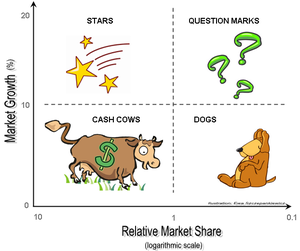Strategic portfolio analysis
| Strategic portfolio analysis |
|---|
| See also |
Strategic portfolio analysis involves identification and evaluation of all products or service groups offered by company on the market (so called product mix) and preparing specific strategies for every group according to its relative market share and actual or projected sales growth rate. It can be also used to make strategic decision about strategic business units.
Portfolio analysis in strategic management allows to answer key questions how to shape the present and future business portfolio (of product or services) in order to reduce the risk of functioning in a changing environment, and increase the effects of the implemented strategy.

Fig. 1. BCG growth-share matrix - one of the most popular strategic portfolio analysis method
Methods of portfolio analysis used in strategic analysis
References
- Adner, R., & Levinthal, D. A. (2004). What is not a real option: Considering boundaries for the application of real options to business strategy. Academy of management review, 29(1), 74-85.
- Bamberger, I. (1981). Strategic Management in Small and Medium Sized Firms by Portfolio Analysis?: A Theoretical and Empirical Study. Universit e de Rennes 1, Institut de Gestion de Rennes.
- Cox Jr, W. E. (1974). Product Portfolio Strategy: An Analysis of the Boston Consulting Group Approach to Marketing Strategies. Proceeds of the American Marketing Association.
- Howell III, J. I., & Tyler, P. A. (2001, January). Using portfolio analysis to develop corporate strategy. In SPE Hydrocarbon Economics and Evaluation Symposium. Society of Petroleum Engineers.
- Morgan, N. A., & Rego, L. L. (2009). Brand portfolio strategy and firm performance. Journal of Marketing, 73(1), 59-74.
- Pethia, R. F., & Saïas, M. (1978). Metalevel product-portfolio analysis: An enrichment of strategic planning suggested by organization theory. International Studies of Management & Organization, 8(4), 35-66.
- Wind, Y., Mahajan, V., & Swire, D. I. (1982). Portfolio Analysis and Strategy.

